Three days to see and do all the things I wanted to during my recent trip up to Chiang Rai were not nearly enough as I wrote in my previous post. However, I am congratulating myself for taking my last day there to venture outside the city to one of several interesting Hill Tribe villages in the surrounding area. All of these towns/villages would have been more easily accessible if I had a motor bike, but that’s an activity I am not fully qualified for at this time. So instead I chose to get to my destination using the available public transportation which happened to be a local bus and then a songtao. *
Doi* Mai Salong is about 65 km. from Chiang Mai. I took a bus from terminal 1 in Chaing Rai to the town of Mae Chan for about 20 baht (under $1). From there I had to find a songtao that would take me the rest of the way to Mae Salong. The cost of one of these can vary depending upon how many passengers the driver can scare up. After a wait of about 20 minutes, I and the other passenger decided we wanted to get going so paid 240 baht each for the long ride up. I wanted to get there before my day was too far gone so was willing to pay the steep price. I think I overpaid but when this is translated into dollars I paid just over $9 for a 37 km ride uphill all the way on a narrow and very curvy road. To me it was worth it!
Before setting out, I read up on at least four towns/villages within a day’s journey from Chiang Rai and chose Mae Salong as my destination for these reasons:
- Mae Salong has a fascinating history which intrigued me. Its origins go back to 1949 after the civil war in China when Chiang Kai-shek’s defeated army was driven out of the country forcing him and his followers to take refuge, first in Taiwan, and then to northern Thailand and Burma (Myanmar today). After many years of fighting trying to regain Hunan in southern China from Mao Tse Tung and his communists, Shek and his troops were given asylum by the Thai government in 1961 on the understanding that they would prevent communism from moving into Thailand. This was the beginning of Mae Salong. The fighting continued over the next 20 years resulting not only in the loss of many lives, but also the beginnings of the opium trade for which this area became infamous. Mae Salong today is a series of villages stretched out over Doi Mae Salong, a mountain range reaching up to 1,200m at its highest peak. The main village of Mae Salong is in the centre of about five other villages and is now called Santikhiri aptly named as it means hill of peace. It is now populated by the Chinese soldiers and their families who intermarried into the Aka, Hmong, Lishu, Yeo, and Karen hill tribes who have resided there for centuries making for a colourful and interesting mix of cultures. The King of Thailand has contributed a great deal of time and money to developing alternate sources of income, such as the growing of tea along with other fruits and vegetables to assist farmers to stop relying on opium as their primary cash crop. The Thai government has also tried to help but the people were slow to accept the change. Now with tourism on the rise and further government help, the opium trade is finally starting to take a back seat in the bus that drives the area’s economy.
- There are at least two large tea plantations which can be visited where you can learn how tea leaves are grown and harvested. Unfortunately, I didn’t have time to visit either, but
I did get a good look at them as my songtao wended its way up the steep and twisting road lined with tier upon tier of green tea plants on both sides. What a beautiful site they made! Oolong tea is king here, and you can drink many cups of it as every tea factory in the villages was offering samples.
- The cherry blossoms were another draw for me. I wasn’t sure if I would have the good fortune to see any as no one seemed to know whether they were out or not. As luck would have it, I did see the beginnings of them in some places where the sun was the hottest. They were just beginning to appear making a lovely blanket of pink. I was told I was about a week too early this year.
- The colourful market, located in Sanikhiri, is another ‘must see and do’ because it’s here where you can see some of the women from the various Hill Tribes dressed in their traditional garb. They are there to market their fruit and vegetables as well as their crafts. I do most of my shopping in Chiang Mai where the prices were actually better so didn’t buy any but had fun looking. Most of their crafts end up in the Chiang Mai markets and shops anyway. Chinese foods and products are also readily available in many of the stalls.
- The Chinese Martyr’s Memorial is another attraction for visitors and another one I didn’t get to see. Better promotion on the part of those working in the tourist industry and a better command of both languages on both sides would have helped me to find this museum. Add to this at least five different Hill Tribe dialects and you have a daunting language barrier to contend with. Having no luck with asking for directions to its location, I gratefully accepted a crude map handed to me by a vendor who spoke a little English. This didn’t help much as most of the wording was in Thai, and when I showed it to any local, they couldn’t read it either. In the end, it was finally another tourist who told me where the Tourist Information office was and suggested I go there for help. But then he added: “It’s closed but maybe it will be open by the time you get there?” If it wasn’t open he then suggested I look for a lady in a green shirt he had met at the market who seemed to be acting as a tour guide. I decided then and there that this was becoming all too complicated. I had enough walking, it was way past lunch time, and I was hungry. Time to look for a place to eat instead of this elusive guide who “perhaps” could tell me how to find the museum.
No doubt I could have benefited from learning a little more about Mae Salong’s colourful past, but in the end I was content to simply spend the time I had wandering around the local school grounds where the classrooms were in separate cabins all nestled in a leafy green environment, walking down the mountain through all the connecting villages snapping pictures, and sipping copious cups of oolong tea before catching the last songtao back into the town of Mae Chan where I could catch my bus back to Chiang Rai.
The trip was definitely worthwhile even though I had to forego a visit to a tea plantation and the museum. I know I could have accomplished this if I had taken one of many organized tours offered in Chiang Rai, but I prefer to go at my own speed. Doing it on my own was less expensive but most important, I could absorb more of my surroundings and have the freedom of discovery that I would not have gotten in an organized group. In retrospect, the ideal way to visit Mae Salong would have been to stay overnight and return on the following day which can easily be done. Mae Salong has accommodations ranging from low to higher priced guesthouses along with a few quite luxurious resorts. Restaurants, other than traditional Chinese, are scarce but I did notice a couple of quaint little coffee and bakery cafes. One day to take in all that Mae Salong has to offer on my own relying on local transportation was simply not enough.
*Songtao – a covered red truck (for certain areas they may be a different colour) with open windows and seats along both sides for about 10 passengers (comfortably).
*Doi – the Thai word for mountain.
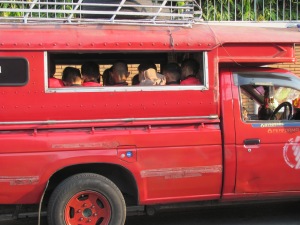
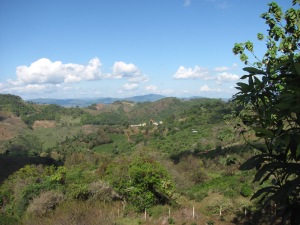

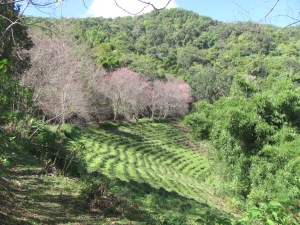
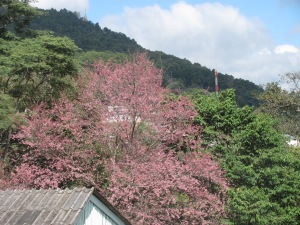

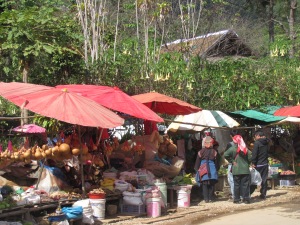


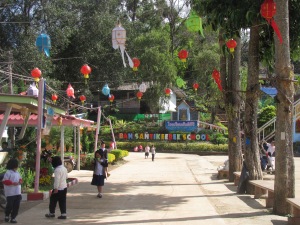



Another great piece, Betty. What was the temperature in the hill area? How much cooler? Thanks again for sharing your adventures. Love and prayers, Helen xixixixixixixixixiixixixi
LikeLike
Hi Helen
Always nice to hear from you. This time I can answer your question. I figure that the temperature up at Mae Salong was about 10 degrees cooler in the area of 18 to 22 degrees. I wore my sweater for most of the time except when directly in the sun. Chiang Rai was probably about 24 to 26 during the day while I was there but in Chiang Mai where, of course, I was most of the time just kept getting hotter. By the time I left it was up into the low 30’s but this year not too humid, thank God. Now I’m in Kampot in southern Cambodia where it’s hot and humid! However, this is still better for me than what they are getting in VB and AR (Annapolis Royal) right now. Sounds and looks from the pictures I’m getting on Facebook as terrible.
Hope you aren’t having too miserable a winter. Keep warm. Love Betty
On Sun, Feb 15, 2015 at 10:19 PM, BetsTravelsAbout wrote:
>
LikeLike
So much fun following your posts! In the midst of a Groundhog blizzard tonite. You are so lucky to be escaping it!
LikeLike
Hi Betty,
Looks like you had a great day. I love the pictures of ‘no snow’ scenery. We are getting dumped on at this time. Last week we had two storms and now another one. I wish I was with you.
I’m sure Jill has given you the latest news about John. I so hope they can help him.
Love, Cheryl
Cheryl Tardif Certified Hypnotherapist Psychosynthesis Counsellor Reiki Master 825-2286 cheryltardif.net
LikeLike
Dear Cheryl
Me too, about John. Let’s think positively for them. I’ve heard about your storms and do sympathize. Think about how wonderful the summers are in NS. Maybe that will help.
On Mon, Feb 2, 2015 at 4:08 PM, BetsTravelsAbout wrote:
>
LikeLike
Well done Bets – sounds interesting! I admire your “get-up & go” spirit!
LikeLike
What a fascinating post! You have so much fun and adventure and it is because of who you are. In my books you are very brave doing all this by yourself and may you be able to enjoy all this for many years yet. Some day maybe I will go too!! Probably I am just joking. What a beautiful country that is. I think I like the sound of Chiang Rai more than Chiang Mai which is so large. I got your letter and will answer next week after a trip to Halifax. Take care, Love, Jill
LikeLike
Wow Betty!! I continue to be impressed with your adventuresome nature…. the landscape is beautiful and you bring it all to life with your delightful storytelling. Thanks for sharing.
Looking forward to having a nice long chat with you when you return. Enjoy the rest of your holiday.
Namaste, Sandra
LikeLike